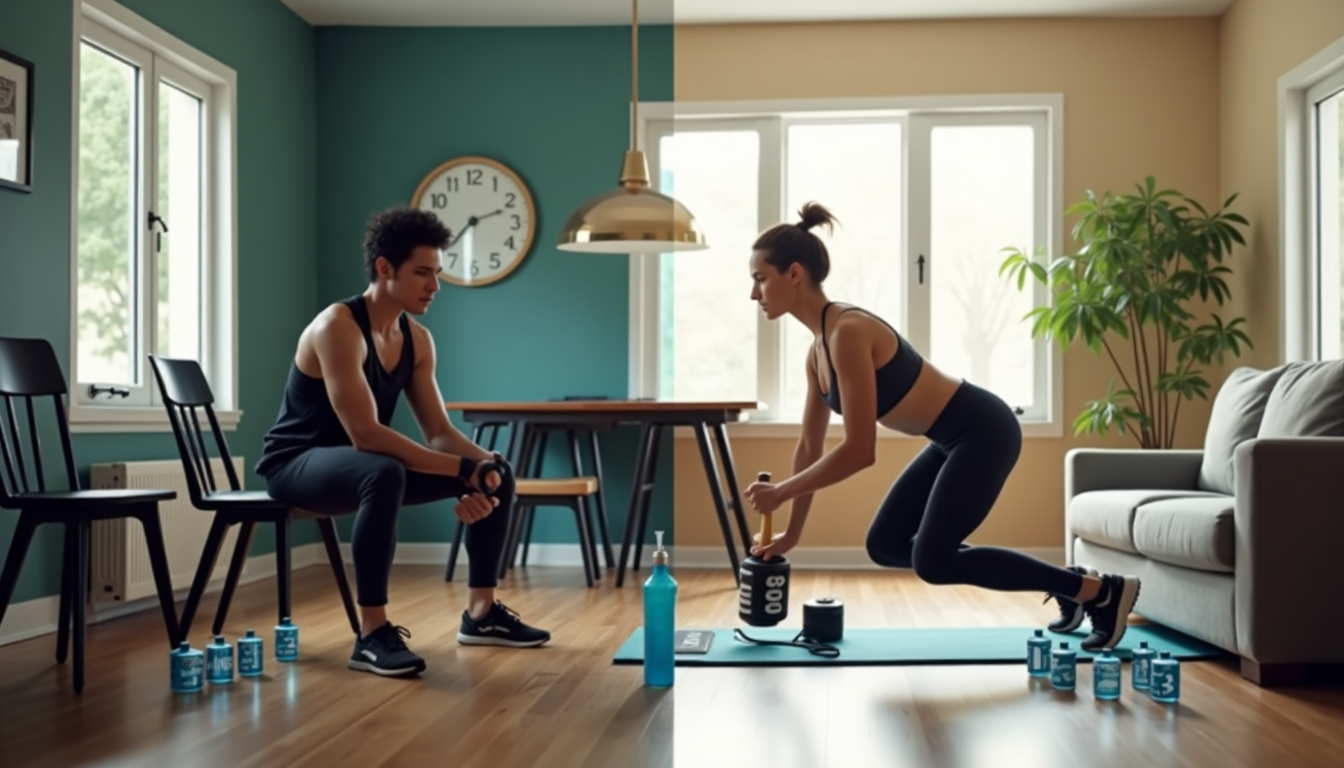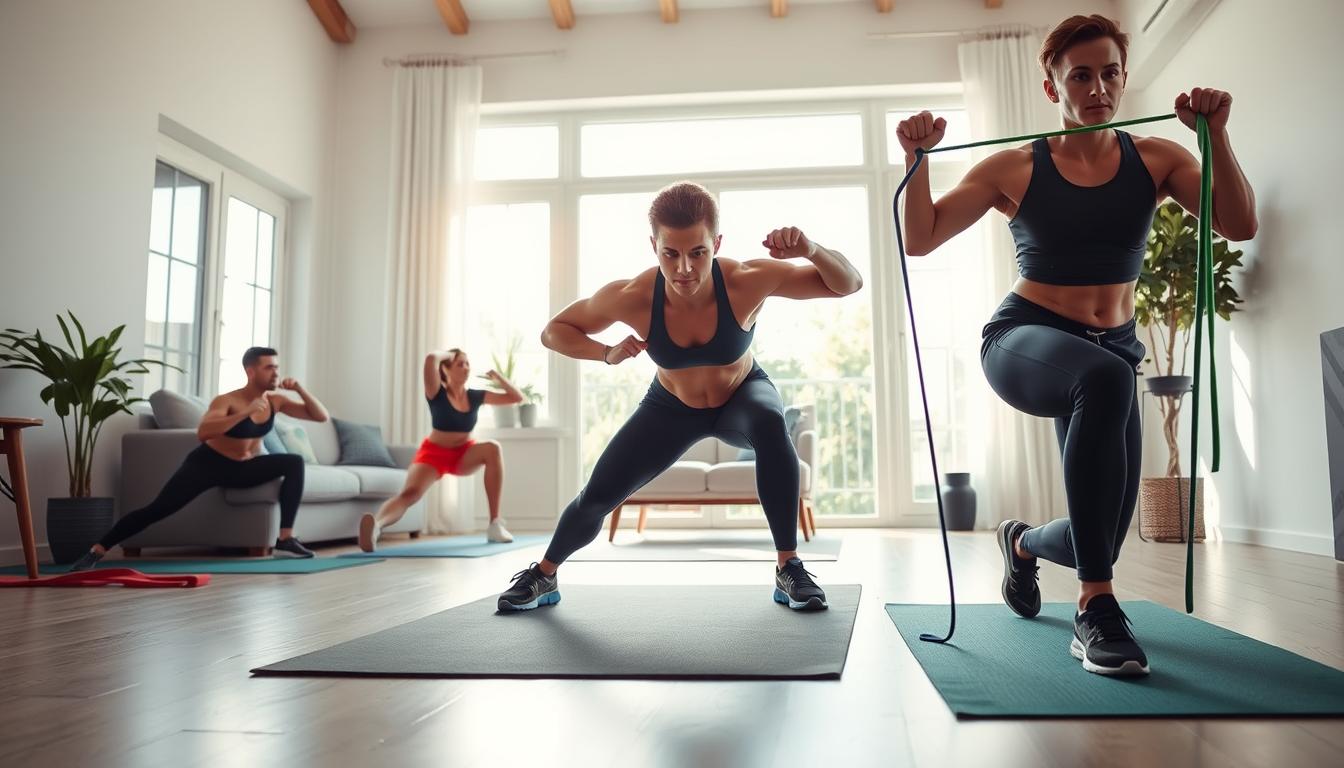You might have good form and consistent workout habits. But common mistakes during home workouts can still hurt your fitness goals. Research shows that many people skip their warm-ups. This mistake can make you more likely to get injured – even if you’re experienced.
Home workouts come with their own set of challenges compared to gym sessions. Makeshift equipment can throw your body off balance. Doing the same exercises over and over leads to overuse injuries and stops you from improving. The National Academy of Sports Medicine stresses proper training structure. They suggest doing four to six sets with six to 12 repetitions to build muscle and strength effectively.
This piece shows you the hidden mistakes you probably make during home workouts. You’ll learn practical ways to train better and safer in your space.
Skipping the Basics: Warm-Up and Form Errors

Image Source: Get Healthy U
Home fitness enthusiasts often skip their warm-ups. They believe their experience will protect them from injuries. This remains one of the most dangerous workout mistakes you can make, whatever your expertise level. Quick HIIT routines or weight lifting sessions in your living room need these basic elements. Skipping them can hurt your progress and health.
Why warm-ups matter more than you think
Warm-ups do much more than just “get you ready” for exercise. Starting your workout with cold muscles puts you at a much higher risk of injury. Your heart rate and body temperature need to rise gradually. This will give your muscles the oxygen they need to perform at their best.
Studies show warm-ups can boost your performance by 1% to 20%. About 79% of research points to better athletic performance after proper preparation. On top of that, warm-ups cut down muscle injuries, which make up over 30% of all sports medicine cases.
Most experienced exercisers still rush or skip their warm-ups completely. Mayo Clinic experts say cold muscles face a much higher injury risk than properly warmed ones. A detailed warm-up should take 5-10 minutes and include:
-
- Light cardio activity to raise heart rate
-
- Dynamic stretching that matches your planned movements
-
- Slow build-up from lower to higher intensity
Warm-ups help you move better, react faster, and stay flexible. Warm muscles bend and stretch more easily. This gives you better movement range and less soreness after your workout.
Common form mistakes even pros make
Even seasoned exercisers make form mistakes that hurt their results and raise injury risks. Good form matters when you exercise and when you handle weights.
Squats and lunges often go wrong. Keep your knees behind your toes and most of your weight on your heels. Here’s a quick test: you should see your toes when looking down and wiggle them without losing balance.
Plank form often needs work too. People either lift their hips too high or can’t keep their bodies straight. You shouldn’t suck in your abs during planks. Keep them engaged while staying aligned.
Moving too fast is another mistake experienced exercisers make. Quick weight movements don’t work as well and rely on momentum instead of muscles. Mayo Clinic experts suggest moving weights slowly and steadily to target specific muscles.
Home exercisers tend to lift weights that are too heavy or too light. Heavy weights can break your form and cause injuries. Light weights won’t build muscle properly. Here’s a good rule: if you can do 8-12 reps with good form, you’ve found the right weight.
It’s worth mentioning that exercise shouldn’t hurt. Stop right away if something feels wrong and check your technique or weights. Pain warns you about possible injuries. Pushing through it can cause serious damage later.
Overtraining Without Realizing It
The worst home workout mistake doesn’t happen during exercise. Your drive to see results might push your body too hard without enough recovery time. This can set you back and hurt your fitness goals.
Ignoring rest days and recovery
Rest isn’t just for beginners – it’s key to any successful fitness plan. Your body builds strength and endurance during rest periods, not workouts. Your muscles need time to adapt, and without enough rest, you’ll hit a wall and stop seeing improvements.
Research shows that working out without rest days leads to overtraining syndrome. This actually makes you perform worse instead of better. Exercise uses up your muscles’ glycogen stores. Without proper recovery time, you’ll face ongoing muscle fatigue and soreness.
“Rest days are just as important as exercise,” fitness experts point out, adding that regular breaks let your body repair itself. Better recovery time leads to stronger lifting sessions with heavier weights.
Doing too much cardio or strength training
The right mix of different workouts matters for home exercisers. You shouldn’t work the same muscle groups on back-to-back days. The best approach is strength training 3-4 times weekly, giving your body recovery time between sessions.
Mix up your exercise types to avoid overtraining. When you do cardio and strength in one session, match high-intensity work with something lighter. To name just one example, follow a tough strength workout with easy cardio, or the other way around.
Working out 6-7 days each week might sound great, but it often fails. Your body becomes prone to illness and injuries without proper rest between sessions. Note that rest days matter just as much as workout days.
Signs your body needs a break
Your body tells you when it needs rest. Watch for these overtraining warning signs:
-
- Persistent soreness: Muscle pain that stays beyond a couple of days shows you need more recovery time
-
- Decreased performance: Your normal routine feels too hard or you stop making progress
-
- Elevated resting heart rate: Your heart rate stays high even when you’re resting
-
- Sleep disturbances: Stress hormones from overtraining can wreck your sleep
-
- Mood changes: Feeling cranky, unmotivated, or moody points to overtraining
Overtraining weakens your immune system. You’ll catch colds and infections more easily. Changes in appetite, extreme tiredness, or losing interest in workouts you used to love are other signs.
The fix is simple: rest. This doesn’t mean sitting still – light walks, gentle yoga, or other easy activities help recovery without stressing your body. Above all, trust your body’s signals. A rest day is needed if your workout feels unusually hard or you’re exceptionally tired.
Improper Workout Planning at Home
Planning is the most underrated part of home fitness routines. Even experienced exercisers make common home workout mistakes in how they structure their exercise plans. You might not get the results you want from your workouts without the right guidance.
Repeating the same routine too often
Your body adapts quickly to physical challenges. The workouts that gave you results at first become your new normal if you do similar routines for months. This leads you to fitness plateaus where you stop seeing progress despite working out regularly.
Your enthusiasm drops as your body gets used to what you’re asking it to do. The workouts feel easier but you don’t see improvements in strength or appearance. Exercises that used to challenge you become too easy – a clear sign you’ve hit a plateau.
You need variety in your workouts to break through this plateau. Research from the University of Tampa shows that a 12-week program with different exercises boosted muscle mass by 11.6% to 12.2%, while repetitive routines only showed 9.3% gains. Your muscles respond better when you change your exercise order or try new movements completely.
Not balancing cardio and strength
Home exercisers often stick to either cardio or strength training. The American College of Sports Medicine suggests doing about two-thirds cardio and one-third strength training. This mix gives you complete fitness benefits and helps prevent injuries from overuse.
Cardio boosts heart health and endurance, while strength training builds muscle and speeds up metabolism. These two types of exercise go together with one another to create better results than either one alone. If you work out four times a week, try 2-3 strength sessions with cardio on other days.
The order of these workouts matters too. You should do strength exercises first when you combine cardio and strength in one session. This will give a better workout since you won’t be tired from cardio before lifting weights.
Lack of progression or overload
You need to gradually make workouts harder to keep improving. The American College of Sports Medicine recommends increasing weight by 2%-10% when you can do one or two extra reps beyond your target.
Your fitness progress will stop without progressive overload. This happens because your brain and body adapt to exercise stress. Your body creates more blood vessels, sends better nerve signals, and builds more muscle tissue when you challenge your muscles.
Here are several ways to implement progressive overload:
-
- Volume progression: Do more total reps (like going from 3×10 to 3×12) or add another set
-
- Weight increases: Lift heavier weights while keeping good form
-
- Tempo variation: Move slower or pause to increase time under tension
-
- Frequency adjustments: Work out one more time each week
Research shows that slower exercises challenge you more by working on stability, coordination, balance, and power, which builds stronger muscles. Women can gain more muscle mass by increasing their resistance training volume.
Note that you should progress gradually – trying to do too much too fast often leads to injury or burnout instead of better results.
Neglecting Nutrition and Hydration
Your workout results depend on what you eat before and after exercise. Many people who exercise at home don’t pay enough attention to this fact. They focus on the workout but overlook nutrition and hydration – vital elements that shape your fitness outcomes and recovery.
Underestimating pre- and post-workout meals
What and when you eat directly affects how well you exercise. Research shows that eating carbs before a workout can improve your performance by a lot. In spite of that, many people make the mistake of exercising on an empty stomach. This can make you dizzy and unable to give your best effort.
The best approach is to eat a balanced meal with carbs and protein 2-3 hours before you exercise. When time is tight, grab a smaller meal rich in carbs and protein 45-60 minutes before starting. The American Council on Exercise suggests drinking 17-20 ounces of water a few hours before exercise and 8 ounces 20-30 minutes before warming up.
What you eat after working out matters just as much. Your body absorbs nutrients best right after exercise. The International Society of Sports Nutrition recommends 20-40 grams of protein within 2 hours post-workout to build muscle. Eating carbs also helps restore the glycogen your muscles used during exercise.
Not drinking enough water during the day
Poor hydration ranks among the most common workout mistakes, especially when exercising at home. Studies show even slight dehydration can hurt your performance. When you lose water, your blood thickens and carries less oxygen to your muscles.
Thirst isn’t a reliable indicator – once you feel it, you’re already dehydrated. Experts suggest drinking 4-8 ounces of fluid every 15-20 minutes while exercising. You should drink about 24 ounces of water for each pound lost during your workout.
A solid hydration plan makes all the difference. Set reminders throughout the day and during workouts to drink something every 15-20 minutes. Keeping a water bottle nearby makes it easier to drink and track your intake.
Workouts lasting more than 45 minutes might need sports drinks to replace lost sodium, which helps your body use fluid better. Remember that good hydration isn’t just about workout performance – it’s basic to your health and recovery.
Using the Wrong Equipment or Setup
Your choice of home workout equipment can affect both safety and results. Many experienced exercisers make basic mistakes at home by not paying attention to their gear and surroundings. Working out without a gym’s professional setup might lead to injuries and less effective sessions.
Wearing improper shoes or clothing
Regular sneakers don’t match what gym shoes can do for your performance and foot protection during exercises. Wrong shoes often cause joint pain, blisters, and make you less stable. Good workout shoes should have responsive cushioning, solid support, and enough grip to keep you steady while moving.
Your treadmill sessions need running shoes with cushioned soles and firm heel support. Strength training works better with shoes that have a lower heel-to-toe drop and wider base for stability. You should replace your athletic shoes after 300-500 miles or every 4-6 months if you work out regularly.
Moisture-wicking fabrics work much better than regular clothes and help prevent chafing and overheating. Of course, proper activewear supports your muscles, lowers injury risk, and lets you move freely.
Using unstable or unsafe household items
Being creative helps when you don’t have much equipment, but using household items can be risky. Make sure furniture is stable and won’t slip before using it as gym equipment. Regular items like chairs with wheels or wobbly surfaces might cause falls and injuries.
Check if handles are secure and weight distributes evenly when using laundry detergent jugs or backpacks as weights. Treadmill accidents often cause broken bones and head injuries, so always use safety features and the right speed settings.
Not optimizing your workout space
A safe workout starts with the right environment. Your home gym needs good lighting to prevent falls, proper ventilation, and temperature control to keep you from overheating. Keep the floor level and free of throw rugs or items that might trip you.
You need enough space to move freely – room for arm extensions and floor exercises. A non-slip exercise mat about half an inch thick protects your joints better than hard floors. Make sure you have enough space around your equipment for easy access and safe movement.
GFCI outlets work best for electrical equipment, and you should avoid extension cords that create trip hazards. Keep your cords organized neatly and think about using dedicated circuits for power-hungry equipment like treadmills.
Conclusion
Home workouts provide convenience and flexibility. These often-overlooked details can transform mediocre results into exceptional ones. Your fitness progress can improve substantially with small adjustments to your warm-up routine, recovery schedule, and workout planning.
Successful home workouts require more than choosing the right exercises. A solid fitness foundation comes from proper form, adequate rest, balanced nutrition, and the right equipment. Pick one area to focus on – start with a proper warm-up routine or review your workout space setup.
Your fitness trip becomes safer and works better when you avoid common mistakes. Experienced exercisers might skip certain simple steps, but these fundamentals help prevent injuries and support steady progress. Look at your current routine, make the needed changes, and you’ll see better results.


